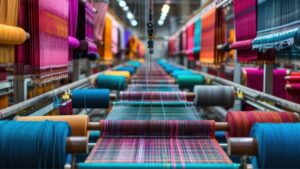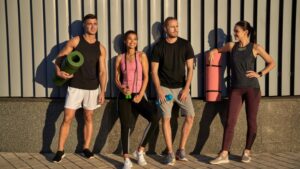 Increasingly, workout clothes with high technology are finding favour as casual outfits, no longer restricted to workouts… yoga pants and gym shirts are becoming popular as streetwear, and even infiltrating the offices in recent years. Retailers are leaving no stone unturned to tap this growing segment and are coming up with innovative ideas, bringing new technology to workout apparels, increasing its appeal for comfort and performance.
Increasingly, workout clothes with high technology are finding favour as casual outfits, no longer restricted to workouts… yoga pants and gym shirts are becoming popular as streetwear, and even infiltrating the offices in recent years. Retailers are leaving no stone unturned to tap this growing segment and are coming up with innovative ideas, bringing new technology to workout apparels, increasing its appeal for comfort and performance.
While some retailers employ the simple strategy of offering the lowest possible price for leggings or gym socks, others in order to stay ahead in the competition have started to offer the newest and most high-tech garments as often as possible. These include gym shirts made of Kevlar, underpants featuring ‘anti-odour technology, no-sweat briefs, lycra made of corn and exercise shorts designed with Cordura, a rugged material often associated with things like car seats and luggage. “Every season now, or at least two or three times a year, the retailers are looking for some new story. Whether it’s the way they’ve constructed the fabric, or whether it’s a new fibre, or it’s a new treatment on the fabric, that’s the expectation they’ve set,” explains Bob Kirkwood, Executive Vice President, Technology and Marketing, Invista Apparel, a company that creates and tests high-tech fabrics in partnership with major brands.
Anke Domaske of Hanover, Germany who founded Qmilk, makes thread out of sour milk using the milk protein casein. The Qmilk fibres, which feels like silk, are resistant to bacteria and fire as the process relies essentially on just milk and water, therefore the result is compostable.
Due to the rough economy and increasing stiff competition, clothing sales have been strained in recent years due to shifting of consumer behaviour and preferences. This is evident in NPD Group’s latest research showcasing a feeble 1 per cent increase in apparel sales during the last 12 months over the same period a year earlier. Nonetheless, workout clothings stand apart as the sales of activewear jumped 8 per cent in the same period becoming a US $ 33.4 billion business. This has been possible due to the advancement in technology as retailers are introducing new techniques and high performance fabric, which is resulting in people buying many more pairs than they actually need. As Marshal Cohen, Chief Industry Analyst at NPD puts it, “Today progressively consumers are looking for something new and innovative. So even if you have workout wear, you will want the new high technology workout wear because it is better.”
To take advantage of this growing segment, many retailers are coming up with something new, Reebok will offer tops, bottoms and footwear in the beginning of 2015 made with Kevlar, which is most commonly known for its use in flak jackets, worn while doing squats. Also, the sports brand has recently released Cordura fabric apparel for activities such as cross-fit training. Chris Froio, Vice President for Training at Reebok states, “Lighter and stronger is what we’re looking at. If everyone is using the same types of yarns and the suppliers, the one key thing you need to do is have a unique selling point, something simple to understand that provides a benefit that consumers really value.”
Similarly, Lululemon has been using a technology called Silveresecent for several years which has ‘anti-odour’ technology that the company claims has materials in the thread, which kills odour-causing bacteria in the garment. “You can wear this thing over time and it will not smell. Even if consumer didn’t wash it, after 24 hours, it wouldn’t smell,” claimed Felix del Toro, Senior Vice President and Head for Men’s Design at the company. Already available in a variety of products, including collared shirts, Lululemon will start selling anti-odour socks this fall. Joining the arms of retailers using this technology is Under Armour, Uniqlo, Athleta and Duluth Trading Company, which offer various lines on anti-odour clothing.
Most importantly retailers are trying to lure customers back for the next season latest thing by speeding up the rate at which new fabrics are appearing in the market or older ones are being enhanced. Beginning this season, Lululemon’s men’s line will introduce something new in its fabric every season; likewise Athleta will also introduce some new or updated material every season. But exclusivity of these high performance fabrics is mandatory for retailers to maintain their hold in the market. In many cases, these fabrics are protected by patents owned by companies that develop them such as Invista, which currently holds a patent on a chlorine-resistant additive aimed at making swimsuit last longer. Among the retailers Lululemon has developed a reputation for aggressively patenting its wares, as it has 36 approved or pending design patents and three utility patents to protect new inventions or materials. For its Silverescent technology, Lululemon has had an exclusive deal with Noble Biomaterials to use the company’s proprietary X-Static technology in its athletic clothes.
These high-tech threads or fabrics are not restricted only to athletic wear as retailers such as the Duluth Trading Company also sells Armachillo work shirts and cargo shorts, which help keep the wearer cool by pulling moisture away from the body, whereas Betabrand sells a hoodie that transmits music from headphone through the sweatshirt’s material without any attendant muffling. Meanwhile, the workout-wear design innovations – such as the flat seams, fabrics that don’t smell, well-thought out pockets, etc. – is helping consumers feel more at ease on a bike or the treadmill allowing one to focus more on the tasks at hand, while giving retailers enough scope to introduce more high technology. As the workout apparel continuously innovates, its demand also keeps growing in the market.






